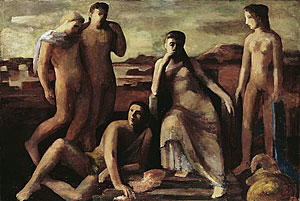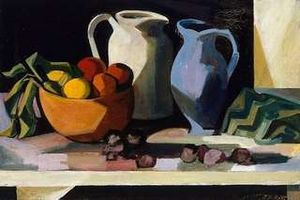Jean Bellette facts for kids
Quick facts for kids
Jean Bellette
|
|
|---|---|
 |
|
| Born | 25 March 1908 |
| Died | 16 March 1991 (aged 82) Palma, Majorca, Spain
|
| Education |
|
| Known for | Painting |
|
Notable work
|
|
| Awards | Sulman Prize 1942 For Whom the Bell Tolls 1944 Iphigenia in Tauris |
Jean Bellette (sometimes known as Jean Haefliger) was an important Australian artist. She was born in Tasmania on March 25, 1908. Jean studied art in Hobart and Sydney, where one of her teachers was Thea Proctor. She also studied in London with famous painters Bernard Meninsky and Mark Gertler.
Jean Bellette was a modernist painter. She was very influential in the Sydney art scene in the middle of the 20th century. She often painted scenes inspired by ancient Greek plays by Euripides and Sophocles, and epic poems by Homer. Jean Bellette is the only woman to have won the Sulman Prize more than once. She won it in 1942 for her painting For Whom the Bell Tolls, and again in 1944 for Iphigenia in Tauris. She also helped start the Blake Prize for Religious Art and was its first judge. In 1935, Jean married artist and critic Paul Haefliger. They moved to Majorca, Spain, in 1957. Even though she visited Australia and showed her art there, she never moved back.
Contents
Jean Bellette's Early Life and Art Training
Jean Bellette was born in Hobart, Tasmania, on March 25, 1908. She grew up as an only child in the countryside of Tasmania. Her mother was an artist, and her father was a postmaster. Jean first went to a local Anglican school. When she was 13, she became a boarder at Friends' School in Hobart. Later, she attended Hobart's technical college.
After that, she became a student at the Julian Ashton Art School in Sydney. Her teachers included Thea Proctor. Another student there was artist John Passmore. In 1934, her drawings and watercolours were shown in a student art exhibition. An art critic from The Sydney Morning Herald praised her work. At Ashton's art school, Jean met fellow Australian artist Paul Haefliger. They got married in 1935. The next year, they traveled to Europe. Jean studied at the Westminster School of Art. There, she was taught by figurative painters Bernard Meninsky and Mark Gertler. In 1938, Jean and her husband studied life drawing in Paris at the Académie de la Grande Chaumière.
Jean Bellette's Art Career
Painting in Australia
Jean Bellette and Paul Haefliger returned to Australia just before World War II started. Soon after she arrived, Jean had an exhibition at Sydney's Macquarie Galleries. The couple became important members of the Sydney Art Group. This group included "fashionable" modern artists like William Dobell and Russell Drysdale. Jean painted and had regular shows. She had a solo show every two years and a group show every year at the Macquarie Galleries. Her husband worked as an art critic for The Sydney Morning Herald for 15 years.
In 1942, Jean won the Sir John Sulman Prize for her painting For Whom the Bell Tolls. She won it again in 1944 with her painting Iphigenia in Tauris. This painting was inspired by Euripides' play. The painting shows a dry, open landscape with riders on horses. Their look suggests modern Australia, not ancient Greece. The judge actually liked another of her paintings, Electra, more. This painting showed Iphigenia's sister, who is also famous in Greek tragedies. However, Electra was not the right size for the competition. Both Iphigenia in Tauris and Electra were among many works Jean created in the 1940s. These works were inspired by the tragedies of Euripides, Sophocles, and Homer.
Jean's choice of classical subjects was a special part of her art. In 1946, her paintings were shown in at least four different exhibitions. Art critics said her work combined the "impulsiveness of romanticism and the carefulness of classicism". They called her approach "romantically classical". Even though most reviews were good, some worried she might start repeating herself. Jean's use of classical subjects went beyond just painting. In 1947, she designed a fabric called "myths and legends." In 1948, she created the sets for a play, Shakespeare's Pericles, Prince of Tyre. Her "strong imagination" for the sets was well-liked.
Even though she didn't win the Sulman Prize again, her works were often chosen for the competition. This included shows in 1946, 1947, 1948, and 1950. Jean kept painting classical scenes. Around 1950, she created the work Chorus without Iphigenia.
In 1951, Jean Bellette came second in the Commonwealth Jubilee Art Competition. The young artist Jeffrey Smart won first place. The next year, she won a competition sponsored by Metro Goldwyn Mayer with her painting Girl With Still Life.
Other critics sometimes reviewed Jean's exhibitions. Describing her 1950 show at the Macquarie Galleries, one critic called it "one of the most exciting and fresh" shows seen in a long time. They said she painted with a "strong, dark palette" and her shapes were "sculpted with great decision."
In 1953, paintings by Jean Bellette were part of an exhibition of twelve Australian artists. This show traveled to London, five British cities, and the Venice Biennale. Jean was one of only two women artists included. Her paintings, like her Sulman prize-winners, had classical themes. These included Electra (1944) and Oedipus (1945).
In 1954, Jean and Paul bought a small house in Hill End. This was an old gold mining village in central New South Wales. They added a studio to the house. It became a weekend getaway and a place for artists from Sydney to visit and create art. This group of artists is sometimes called the Hill End Group. They are known for their landscape art. Jean was known for her classical subjects and still lifes. Several of her still lifes from this time are in public collections. These include Still Life with Fish (1954) and Still life with wooden bowl (around 1954).
In 1955, Jean Bellette helped start the Blake Prize for religious art. She was also the first judge for this prize.
Life and Art in Majorca
Jean Bellette and Paul Haefliger left Australia planning to get a divorce, but they ended up staying together. After a year in Paris, they settled in Majorca, Spain. They first lived in Deià before buying a house in a small village called C'an Baxu. Jean painted landscapes and still lifes that showed a Spanish influence. An example is Spells for Planting (1964). The Art Gallery of New South Wales bought this painting the same year it was shown in Melbourne. Jean had several shows in Australia throughout the 1960s. The year she moved to Majorca was the last time she showed her work outside Australia. The couple visited Australia in 1970 and 1975. Jean returned one more time in 1983.
Jean became less involved in the Australian art scene. This was partly because Australian art was changing. Abstract expressionism was becoming popular, and there was more discrimination against women artists. However, Jean was still able to have some exhibitions in Sydney and Melbourne. These shows, though not frequent, were very well received by critics. When her work was shown at the South Yarra Gallery in 1964, art historian Bernard Smith praised it highly.
Jean Bellette and Paul Haefliger lived and worked in Majorca for the rest of their lives. They often took trips to Italy. Friends like artists Jeffrey Smart and John Olsen visited them regularly in Europe. In 1976, an injury to her wrist meant that the paintings she prepared for a solo exhibition were her last. Paul Haefliger died in March 1982. Jean survived breast cancer in 1986 and passed away on March 16, 1991.
Jean Bellette's Legacy
Before she died, Jean Bellette gave her Hill End cottage to the National Parks and Wildlife Service. She asked that it be used as a place for artists to stay and work. It is still used for that purpose today. As of 2016, Jean Bellette is the only woman to have won the Sulman Prize more than once.
Many of her artworks are held by the Art Gallery of New South Wales. Other galleries that have her paintings include Bathurst Regional Art Gallery, the Art Gallery of South Australia, Art Gallery of Western Australia, Bendigo Art Gallery, Geelong Art Gallery, the National Gallery of Australia, and the Tasmanian Museum and Art Gallery. From 2004 to 2005, a large exhibition of her work was held. It traveled to several galleries, including Bathurst Regional Art Gallery and the S. H. Ervin Gallery in Sydney.
Jean Bellette is seen as an important figure in the modern art movement in Sydney during the mid-20th century. Art historian Janine Burke called her "a leader of the post-war art world." The University of Queensland Art Museum's curator described her as a "key figure in the visual arts from the 1930s until her death in Majorca in 1991."
See also
 In Spanish: Jean Bellette para niños
In Spanish: Jean Bellette para niños



